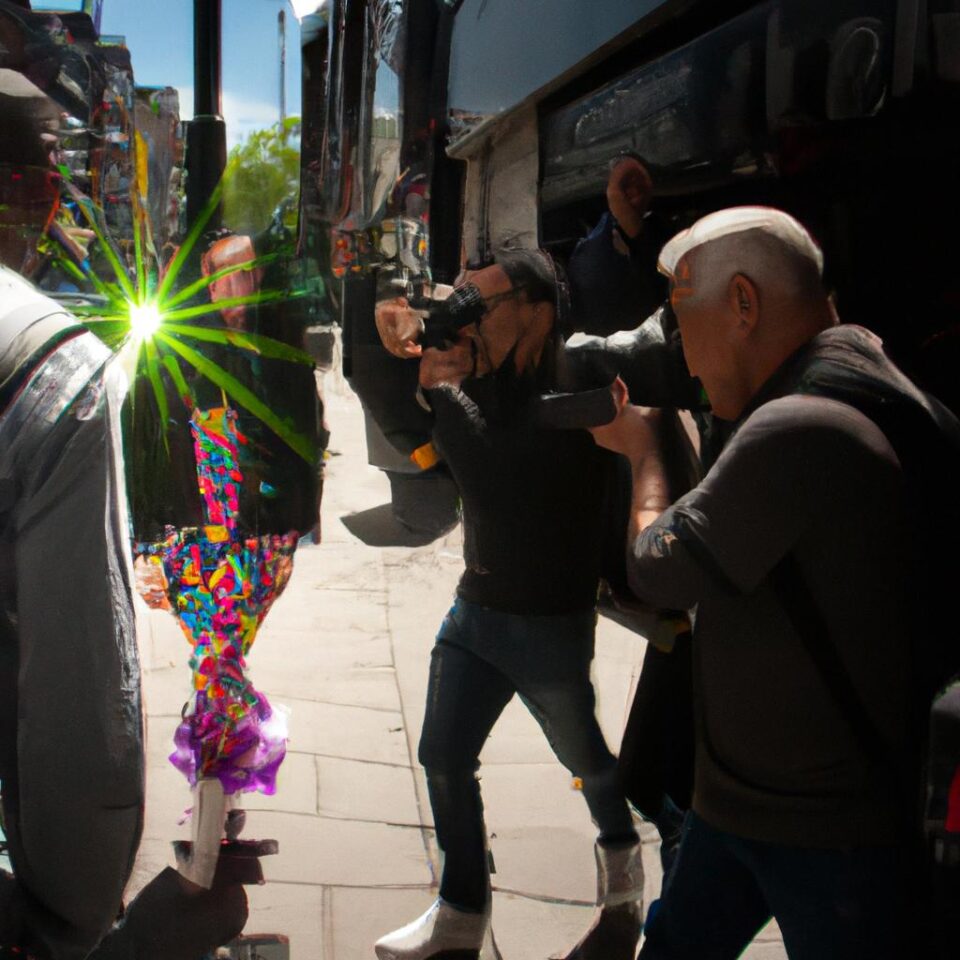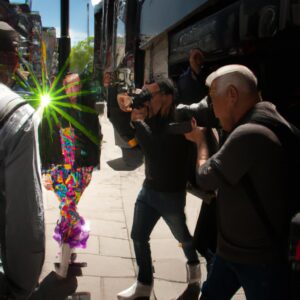Exploring Vibrant Street Scenes in Urban Photography
Cities come alive in urban photography, filled with vibrant street scenes. Bright colors, dynamic motion and captivating moments can all be captured in creative and unique ways by photographers. In this guide, we’ll explore what makes vibrant urban photography street scenes so special, explore tips for creating your own, and review examples of established street photographers to help inspire your work.
Historic Context
Street photography as an art form has an incredibly long and storied history and is traced back to the late 19th century. Early street photographers, such as Jacob Riis and Walker Evans, captured a glimpse of life through a changing landscape. Evans in particular was known for his ability to take vivid photos of everyday life that highlighted the vibrancy of its inhabitants.
Evans’ work employed various techniques to create striking scenes. He often used saturated colors, light, and contrast to create dynamic images with great vibrancy. He even used flash at night to illuminate the streets in anotherwise darkened area, capturing the full range of vibrant colors in the scene.
By taking a look at the work of early street photographers, we can develop an appreciation for how past masters of the artform have utilized vibrant colors to create captivating street scenes.
Buzzwords to Consider
When capturing vibrant street scenes, there are some important terminology to consider. We’ll briefly cover the common buzzwords that photographers often use when discussing their work.
- Aperture: This refers to the size of the opening in the lens when taking a photograph. A larger aperture will allow more light into the camera, while a smaller one will give you more depth of field.
- Depth of Field: Depth of field (or DoF) is the zone within a photograph in which objects are in focus. It’s important to consider when shooting vibrant scenes as it can be used to add further emphasis on certain elements.
- Shutter Speed: The shutter speed of your camera is the amount of time the shutter stays open while taking a photograph. Slower shutter speeds allow you to capture movement or motion in a scene, while faster shutter speeds produce clear images with no motion blur.
- ISO: ISO is the measure of a digital camera’s sensitivity to light. Higher ISOs will result in grainy photos with more noise, while lower ISOs will give you crisp and detailed images.
- Lens Selection: Different lenses have different characteristics, such as wide-angle or telephoto. When shooting vibrant street scenes, it’s important to consider the type of lens you’re using to capture the most dynamic images.
Light and Color
When setting up an image to capture vibrant street scenes, light and color are of primary importance. The play of both can often make a street scene come alive, as colors can add depth and texture while light can add drama and atmosphere.
The way that light and color interact is key to truly capturing the vibrancy of a scene. Different hues can contrast with one another, while highlights and shadows create depth. Contrasts in color can also add dynamism to an image, drawing attention to certain elements or points.
Pay attention to how the sunlight interacts with your subject and how it changes throughout the day. Consider where the dominant source of light is coming from and how you can use this to your advantage – for example, in the late afternoon, the sun might be low in the sky, creating long shadows and warm, golden tones.
Don’t discount the importance of color when composing your photo. Look for areas that have strong contrasts to really make the colors pop, possibly in the form of a brightly dressed individual or neon signs. Adding some kind of strong color can help to emphasize the vibrancy of the scene.
Choosing Your Subject
When you are looking to capture vibrant street scenes, the most important element is always going to be your subject. Choosing a subject can be daunting, but it doesn’t have to be. Here are some tips for choosing a subject that will guarantee compelling street scenes.
- Look to capture everyday life. People, traffic, street signs – all of these things can be fascinating when taken from the right perspective.
- Find contrast and juxtaposition in the scene. People next to modern buildings or traffic on old cobbled streets can create a dynamic story in your image.
- Watch for bright colors or patterns. This could be clothing, flags, banners, or anything that adds a pop of vibrancy to the image.
- Persevere, take time to wander and observe. You never know what kind of interesting scenes you might come across.
Focusing in on the right subject can be a great way to create captivating street scenes. With a little bit of planning and preparation, the possibilities are endless!
Focusing On the Details
When you’re out in the streets looking to capture vibrant street scenes, it’s important to pay attention to the small details that will make your photos stand out. Even the seemingly insignificant elements of a scene can contribute to the overall message or mood you’re trying to portray. Sometimes all it takes is a splash of color to turn an everyday scene into something special.
Look for interesting juxtapositions of colors, elements and shapes. Also focus on how light plays a role in bringing out the colors in a scene — you can use back lighting, sidelighting, and reflections to enhance the vibrancy of a street scene. Taking time to observe the environment and patiently waiting for the right moment to capture your shot can bring great rewards.
Capturing Dynamic Motion
To create a captivating street scene, taking advantage of dynamic motion can be of great help in engaging the viewer. By experimenting with exposure, shutter speed and changing angles, you can capture a street scene fully charged with energy.
When capturing dynamic motion, it is important to consider timing, as well as how you can use movement to convey an emotion or story. You can also experiment by taking shorter and longer exposures to create different outcomes. If taking a longer exposure, you can try using neutral density filter to reduce the amount of light entering the lens.
Experimenting with shutter speed and continuous shooting will help you get a better understanding of capturing motion. With continuous shooting, you can capture the same moment from several perspectives, providing a richer outcome. Using a panning technique or zooming the lens while shooting can also create an intriguing dynamic effect.
By exploring these techniques and learning to experiment, you can become more confident with capturing vibrant street scenes.
Developing Post-Processing Techniques
One of the most important elements of capturing vibrant street scenes is leveraging post-processing techniques. Post-processing is where a photographer can adjust the color, contrast and sharpness of the image to enhance the vibrancy and capture exactly what they saw in person.
When it comes to post-processing, there are a few key techniques to consider:
- Adjusting white balance – setting the right white balance allows you to properly adjust the tones and hues of colors for maximum vibrancy.
- Sharpening the image – a slight increase in the sharpness of an image can help emphasize the details and make the colors appear stronger.
- Adding contrast – adding contrast can help separate colors from one another and add definition to the image.
- Local adjustment – when needed, a local adjustment can be applied to specific areas of the image to enhance colors and lighten or darken certain tones.
By taking the time to understand these post-processing techniques and experimenting with them in your workflow, you can quickly become better at creating vibrant street scenes.
Specific Exercises to Try
Attempting to capture vibrant street scenes can be daunting, but with the right exercises you can become an expert in no time. Start out by practicing photography in a familiar area to you. This could be your hometown or even your own neighborhood. Go out and use different settings and angles to see which works best for creating a vibrant street scene. Practice experimenting with the light and color available to create captivating photographs. You can also practice different focusing techniques to see the effects they have in capturing dynamic motion. Try to get creative with the post processing techniques that are available and decide which ones will help enhance the vibrancy of the image.
Great Ideas to Incorporate into Your Work
Capturing vibrant street scenes means thinking outside the box. Creative ideas can help you elevate your work and create memorable pieces that stand out from the crowd. Here are a few great ideas to consider incorporating into your work:
- Experiment with unexpected angles and perspectives.
- Leverage natural shadows for added drama.
- Look for abstract compositions.
- Incorporate leading lines.
- Create layers of texture.
- Utilize reflective surfaces.
- Capture reflections in puddles.
- Find vibrant colors in everyday objects and places.
- Include people in your street scenes, or blur them out.
By considering these ideas when shooting, you may be able to make images that feature more dynamic colors and interesting subjects that make your work stand out from the rest.
Examples from Established Street Photographers
Capturing the vibrancy of a street scene can take years to master. Experienced street photographers have managed to produce stunning images of urban life that will live on forever. To gain a better understanding of composition and dynamics, it is beneficial to take a closer look at some of their work.
For example, Vivian Maier’s photos of 1950s Chicago capture the essence of street life at the time. Her use of vibrant color and contrast to convey the atmosphere of the city are unparalleled. Henri Cartier-Bresson also managed to capture the motion and emotions of cities around the world with his remarkable photos of the 1920s and 1930s.
More recently, Josef Koudelka has captured his native Prague in a unique style. His photos show how vibrant street scenes can be even in a place with little sunlight. Stephen Shore is also known for documenting everyday life in America, and his works are filled with warm colors.
By looking at the works of experienced street photographers, you can learn a thing or two about composition, light, and color. So take a look at some of the incredible work out there and see where it takes you.
Conclusion
Exploring vibrant street scenes in urban photography is an interesting and rewarding endeavor. By understanding the context of historic street photographers, the importance of light and color, and focusing on the details, you can capture stunning vibrant street scenes. Additionally, by developing post-processing techniques and trying out specific exercises, you can develop your skillset for capturing vibrant urban scenes. Furthermore, incorporating creative ideas into your work can help you stand out from the crowd. Examples of vibrant street scenes from experienced street photographers can serve as an inspiration for your work. We hope this guide has given you the fundamental knowledge you need to explore vibrant street scenes in urban photography.
To learn more about the topic, visit websites such as:
comments: 0

